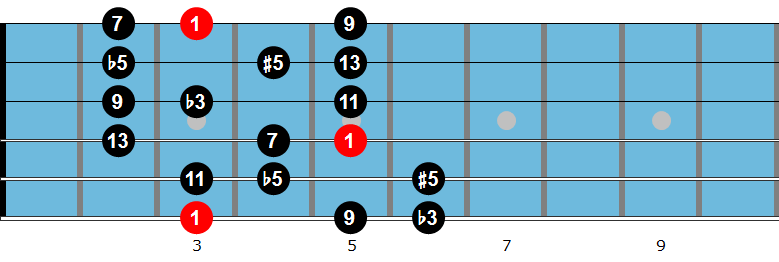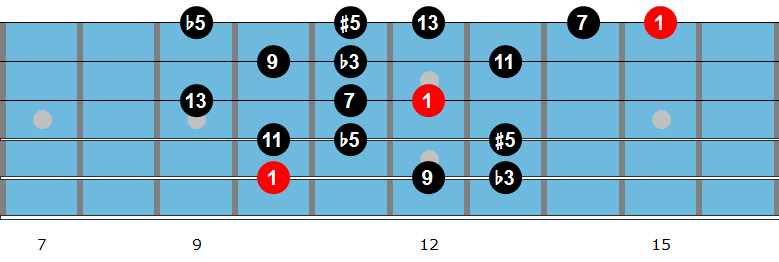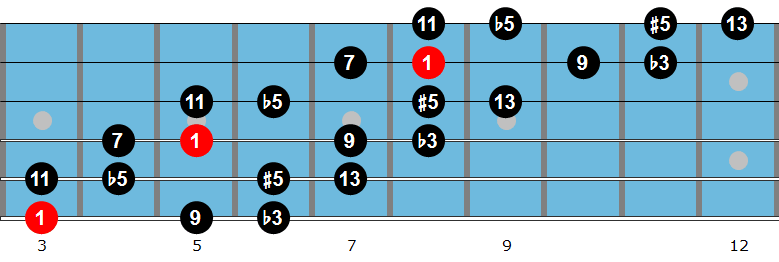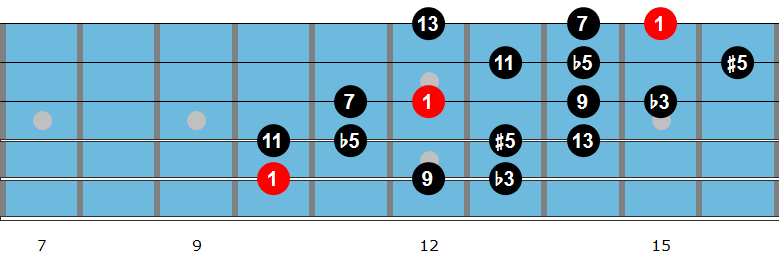The diminished scale is a symmetrical scale that is built by alternating whole steps and half steps. This scale is used to solo over diminished seventh chords. Dim7 chords are not as commonly used as minor, dominant or major chords, but when they do pop up, they have a tendency to handcuff beginning improvisers. This lesson will introduce you to the diminished scale. Mastering this scale will allow you to confidently and musically solo over Dim7 chords the next time you encounter one in a jazz tune.
This lesson will explain how to build, play, and solo with the diminished scale. You will learn practice patterns, arpeggio patterns, and sample licks to help take your Dim7 soloing phrases to the next level.
What Is The Diminished Scale?
The diminished scale is an eight-note scale that is built by picking a tonic note, and then alternating whole steps and half steps from that starting note. Because of that it is also commonly referred to as the whole-half diminished scale.
To help you visualize how the diminished scale is constructed, here is a chart that lays out the interval structure for this scale. It also shows you how the whole (W) and half (H) steps are used to create this octatonic scale.
| Diminished Scale | 1 | 9 | b3 | 11 | b5 | #5 | 13 | 7 | 1 |
|---|---|---|---|---|---|---|---|---|---|
| W | H | W | H | W | H | W | H |
The diminished scale is used to solo over diminished 7 (Dim7) chords.
The diminished scale is different from the dominant diminished scale, which alternates half and whole steps and is used to solo over dominant 7b9 chords.
When first exploring diminished scales on guitar, it is easy to confuse these two scales. To help keep them separate in your head, and on the fretboard, here is a quick way to think of each scale:
- Dominant 7b9 diminished = half-whole
- Dim7 diminished = whole-half
Diminished Scale Fingerings
To begin your study of diminished scale fingerings, here is a two-octave shape from the 6th string that stays in position. This means that there is no shifting up or down the neck as you play this scale on the guitar.
This scale is written from the root note G, and so it is called a G diminished scale. Once you can play this fingering, make sure to move it to other keys.
Listen & Play Along

You can also play an in-position G diminished scale from the 5th-string root note, which you can see and hear in the following example.
Listen & Play Along

Here is a G diminished scale from the 6th string that shifts up the neck, which is an effective fingering to move between positions on the guitar.
Listen & Play Along

The final fingering in this lesson is a G diminished scale from the 5th string that shifts up the fingerboard.
Listen & Play Along

Once you can play these diminished scale fingerings, put on a Dim7 backing track and begin to solo over that chord using the fingerings from this lesson.
As well as learning to play these scales on the guitar, it is also important to take these shapes to the improvisational side of your studies so you can apply them to jazz tunes and progressions.
Diminished Scale Practice Patterns
Next, you will learn to play four variations of a common jazz scale pattern called diatonic thirds.
Here it is applied to the G diminished scale from the 6th string root. Any of the patterns in this section of the lesson can be applied to any key and fingering.
To begin, here are ascending 3rds through the G diminished scale.
Listen & Play Along

Moving on, here are descending 3rds played over a G diminished scale.
Listen & Play Along

The next practice pattern variation features the first 3rd ascending followed by the second 3rd descending. This is referred to as alternating 3rds.
Listen & Play Along

The final practice pattern is a reversal of the pattern you just learned. You are playing the first 3rd descending, followed by the second 3rd ascending.
Listen & Play Along

Diminished Scale Arpeggios
When studying diminished scales, one of the most interesting concepts that you can explore is the use of both Dim7 and dominant 7th arpeggios through this scale.
Because you can solo over Dim7 chords with the diminished scale, it is no surprise that you can use Dim7 arpeggios built from this scale. Many of us may not be aware though that you can also use dominant 7th arpeggios from the scale to solo over Dim7 chords.
To understand this concept, let’s break down a C diminished scale by first looking at its notes:
| C diminished scale | C | D | Eb | F | Gb | G# | A | B | C |
|---|
When you build arpeggios from the 1st, 3rd, 5th, and 7th notes of this scale you produce 4 Dim7 arpeggios:
- Cdim7 = C Eb Gb A
- Ebdim7 = Eb Gb A C
- Gbdim7 = Gb A C Eb
- Adim7 = A C Eb Gb
Now, let’s take a look at the four arpeggios that you build when starting from the 2nd, 4th, 6th and 8th notes of the scale, which are all dominant 7th arpeggios:
- D7 = D F# (Gb) A C
- F7 = F A C Eb
- Ab7 = Ab (G#) C Eb Gb
- B7 = B D# (Eb) F# (Gb) A
To see these arpeggios on the guitar, here are the ascending versions of each arpeggio in a C diminished scale:
Listen & Play Along

Here is a G diminished scale from the 6th string with the ascending arpeggios applied to this fingering:
Listen & Play Along

Diminished Scale Licks
To finish this introduction to the diminished scale, here are six licks that you should study and apply to your playing.
The first lick uses 3rds to solo over a Dim7 chord, in a four-bar phrase.
Listen & Play Along

Moving on, the second lick uses a Bb diminished scale to solo over a Bbdim7 chord in a iiim7-bIIIdim7-iim7-V7 progression.
Listen & Play Along

The third lick in this lesson uses the same Bb diminished scale over a Bbdim7 chord, though in this case, you will draw from the arpeggios in that scale to build your line.
Listen & Play Along

This line features a common scale pattern (1235) over the first three chords in this Rhythm Changes chord progression, including the Bdim7 chord in the second half of the first bar.
Listen & Play

In this next line, you will use the Db diminished scale to solo over a popular jazz chord progression, iiim7-biiidim7-iim7-V7, in this case in the key of Bb major.
Notice that the Dbdim7 bar features a diminished scale descending straight down from G to A, though halfway through the notes are raised an octave, rather than just continue straight down the scale in the original octave. This technique is known as octave displacement and is used by many great jazz guitarists including Wes Montgomery, Joe Pass, and others.
Listen & Play

The final phrase is applied to the middle four bars of a jazz blues progression in the key of C. The diminished scale here features a melodic pattern over the second bar of the progression.
Listen & Play

The diminished scale is often a bit tricky to study on the guitar, compared to the major scale modes which are usually quicker and easier to work out on the fretboard. But, by working out various fingerings and practice patterns, you will ensure that you are ready to nail any Dim7 chord in your soloing lines the next time you run into one.
More Guitar Scale Lessons



Thank you JGO for the study in diminished scales. My instrument is piano; however your guitar-based instruction is easily applied to the keyboard with equally good results. For me, you have made a complex subject understandable by breaking it down, then showing how to build up any desired construction from the elements. Today is the first time I am not afraid to improvise over a chord marked “dim.” It’s gonna take practice, but I can see my way now!
Another great lesson !
Thanks a lot for all this knowledge .
May God ( Coltrane ) give you all the best !
Thank you for this interesting article.
For arpeggios on 2,4,6 and 8, one can choose dim7 chords instead of 7 chords, I think; which gives:
Ddim7: D F Ab (G#) Cb (B)
Fdim7: F Ab (G#) Cb (B) Ebb (D)
G#dim7: G# B D F
Bdim7: B D F Ab (G#)
Which seems to indicate that one can use C diminished scale (as well as D diminished scale) on a Ddim7 chord. What do you think of this?
Wow! This is a fantastic lesson. I’m sure I can spend a month practicing just the exercises on this page. Thanks so much!
Mark